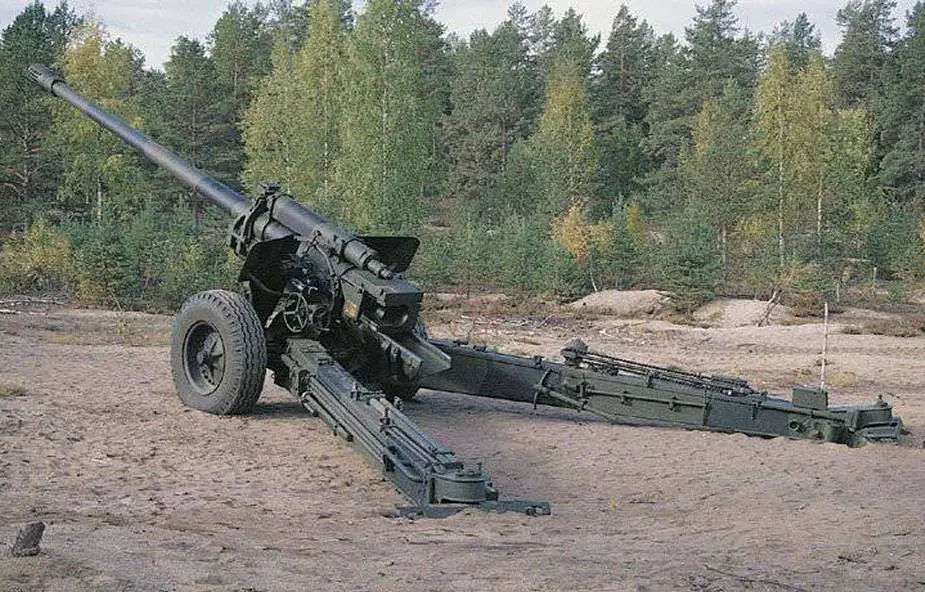- Army
- Conflicts in the world
- Israel - Iran conflict 2025
- Pakistan - India Conflict 2025
- Russia Ukraine War 2022
- Libya conflict day by day
- HAMAS - Israel War 2023
- Operation Serval in Mali French Army
- Sangaris operation Central African Republic
- Sangaris opération militaire République Centreafrique
- Ukraine - Russia conflict
- Syria conflict news
- Defence & Security Industry Technology
- Armies in the world
- Analysis Defense and Security Industry
- Conflicts in the world
- Navy
- Air
Ukraine army uses old Soviet 130mm M-46 guns received from Croatia
As written on en.topwar.ru, the shortage of artillery is forcing the Ukrainian army to re-use old guns that had already been withdrawn from service in the armies of other countries. Among these ‘’museum pieces’’ are howitzers dating back to the Soviet Union era immediately after the Great Patriotic War 1941-45).
Follow Army Recognition on Google News at this link

Soviet-era M-46 130mm towed howitzer in a Russian museum (Picture source: Wikipedia)
As an example, Croatia recently handed over to Ukraine a batch of M-46 towed field guns of 130 mm caliber, model 1953 (or 1954), of Soviet production, en.topwar.ru reports. These guns had served when Croatia was still a part of Yugoslavia and were later removed from service for storage. Upon request from Ukraine, 15 of these guns were sent (sold or given?) to this country but no information on the delivery date nor the possible accompanying ammunition stock is available.

Soviet-era M-46 130mm towed howitzer. This piece has been modernized, when compared to the original model displayed in museums (Picture source: en.towar.ru)
130 mm towed field gun M1954 (M-46)
The 130 mm towed field gun M-46 is a manually loaded, towed 130 mm artillery piece, manufactured in the Soviet Union in the 1950s. It was first observed by the west in 1954.
This gun was created to replace the 122-mm A-1931 gun of the 37/19 model and was intended to combat heavy tanks and self-propelled artillery, destruction of defensive structures, etc. The M-46 was developed from the M-36 130 mm naval gun used on ships and for coastal defence. It is a true gun, being unable to fire much above 45° and having a long barrel and a single propelling charge. In contrast, most Western field guns of this period had a dual high and low angle fire capability, a gun-howitzer.
A prototype was made in 1950. The release of small series was started in 1951 It was adopted in 1953 and continued until about 1971. During this time, several thousand M-46s were produced. The gun was also in service with the armies of the Warsaw Pact countries. Currently, it is still in service with a number of countries in Asia, the Middle East and Africa. For many years, the M-46 was one of the longest-range artillery systems around, with a range of more than 27 km. (16.7 mi).
It has a 39 calibre barrel with a tied jaw horizontal sliding-block breach and 'pepperpot' muzzle brake. The latter is not notably efficient, but subjective reports suggest that it is quite effective in reducing muzzle flash. The hydro-pneumatic recoil system comprises a buffer below the barrel and a recuperator above the barrel. The long barrel enables a substantial propelling charge by providing more length in which to achieve 'all-burnt' and hence projectile acceleration space and thus achieve its 930 m/s muzzle velocity.
The barrel is mounted on a split-trail carriage, with deep box section trails and foam-filled road wheels on the ground when firing and 50° of top traverse. The small shield protects little more than the sights, possible including from the effects of muzzle blast, and some protection from machine gun fire in anti-tank engagements. The gun has long and robust trails to provide stability when firing, a large detachable spade is fitted to the end of each when the gun is brought into action.
Non-reciprocating sights are a standard Soviet pattern, designed for one-man laying. Included are a direct fire anti-tank telescope, a panoramic periscopic indirect-fire sight (a dial sight) in a reciprocating mounting, an angle of sight scale, and a range drum engraved with the range (distance) scale, coupled to a mounted elevation levelling bubble. The range drum enables the standard Soviet technique of semi-direct fire when the piece is laid visually on the target and the range set on the range drum. An APN-3 was later provided for direct fire at night in place of the day telescope.
For travel, the gun is towed via a two-wheeled limber fitted to the end of the closed trails, with the spades removed and carried on each trail. Simple jacks on the trails just behind the main wheels are used to lift and support the closed trails so that the limber can be connected. The barrel and recuperator are pulled back between the closed trails and locked in a travelling position. There is a large bicycle chain arrangement on the right trail for this, and a compressed air cylinder, charged by the gun firing, is used to bring the barrel forward when the gun is brought back into action. It takes about four minutes to bring the gun into action, the normal detachment is eight strong.
Propelling charges are in metal cartridge cases and loaded separately from the projectile. Projectiles originally included HE fragmentation, Armour Piercing solid shot, smoke, illuminating and chemical. HE shells weigh some 33 kg. Illuminating shells have a substantially lower muzzle velocity. APHE and extended range shells were introduced later. The maximum rate of fire is probably 6-7 rounds/minute, and about 70 rounds/hour, with a maximum firing range of 27,5 km.


























